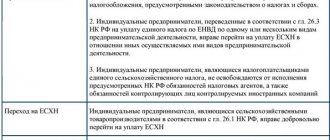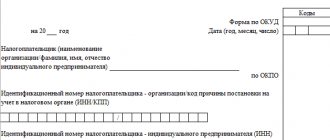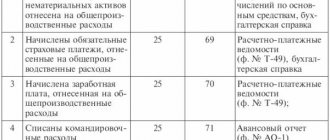Rules for maintaining a ledger of income and expenses
Entries in the book are made only if there is appropriate supporting primary documentation. If there is no document, then information about the operation is not allowed to be entered into the book.
- The obligation of the individual entrepreneur is to provide reliable and complete information, to ensure the continuity of its reflection in a special book. The correct display of the necessary indicators during the period will allow the entrepreneur to correctly calculate the base and amount of the agricultural tax.
- Organizations working for the Unified Agricultural Tax are required to keep full accounting records using accounting registers, consistently reflecting each transaction performed using double entries. If, according to the necessary criteria, an LLC can be classified as a small enterprise, then this does not eliminate the need for accounting, but accounting activities can be carried out in a simplified form. Read also the article: → “What types of activities on UTII are suitable for an LLC?”
Results
Compliance with the rules for maintaining CDR under the Unified Agricultural Tax allows you to timely and fully reflect the income and expenses involved in the calculation of agricultural tax. Particular attention must be paid to expenses - their documentary evidence, economic feasibility and compliance with the list of expenses allowed by the Tax Code.
Sources: Tax Code of the Russian Federation
You can find more complete information on the topic in ConsultantPlus. Free trial access to the system for 2 days.
Rules for filling out the accounting book for the Unified Agricultural Tax
The following requirements apply to registration of an account book:
- Filling out is carried out in Russian, information about documents in a foreign language must be translated into Russian;
- The chronological sequence, reliability, and continuity of records must be ensured;
- The registration of the book is carried out throughout the calendar year, at the end of which the accounts are entered into a new book;
- Entering information into the book is only possible if primary paper is available;
- Making corrections to the paper version of the accounting book is possible if each adjustment is certified by the signature and seal of the individual entrepreneur (if there is a seal), as well as by indicating the date of the changes. Moreover, corrections must be justified.
Method of maintaining an accounting book for individual entrepreneurs
Electronic and paper methods of maintaining an accounting journal are allowed; the decision on a convenient method of registration is made by the entrepreneur independently. Each method of maintaining a book has its own characteristics that must be taken into account when organizing accounting activities.
The paper format of the ledger must have sequential page numbering and all sheets bound together. On the last page the total number of sheets of the book is written, this entry is certified by the personal signature of the individual entrepreneur; if there is a seal, then it must be placed next to the signature.
Before you start maintaining a paper copy of the book, you must submit it to the tax office to receive a mark from a tax specialist and a stamp from the Federal Tax Service.
At the end of the tax period, an electronically prepared book is put out on paper; after printing, the number of pages of the book is written on the last sheet, this entry is certified by the signature of the individual entrepreneur.
Next, the book must be taken to the Federal Tax Service office, where a tax specialist’s signature and tax stamp will be affixed. Certification by the Federal Tax Service must be completed within four months from the end of the tax period (until the end of March).
All of the above actions will allow you to avoid fraud, eliminate the deletion of sheets, their addition, and changes in the indicators used in the calculation procedure of the tax burden under the Unified Agricultural Tax. Read also the article: → “Conditions for applying the Unified Agricultural Tax + payers, calculation.”
| Contents: 1. Maintaining the accounting policy of the unified agricultural tax at the enterprise 2. Maintaining a book of income and expenses under the unified agricultural tax for individual entrepreneurs and organizations 3. Conditions for using the unified agricultural tax + infographics, calculation 4. Step-by-step instructions for registering private household plots 5. Taxation of peasant farms: comparison of the OSNO, simplified tax system, unified agricultural tax regimes 6. How to switch to the Unified Agricultural Tax from the general regime and the simplified tax system? Infographics 7. How to register a peasant farm: step-by-step instructions 8. Application of the Unified Agricultural Tax for peasant farms: infographics, calculation example, payment deadlines |
That's what the law says
The creation of such a book was required by order of the Russian Ministry of Finance number 169. According to this document, the head of a peasant farm is actually endowed with the rights of a legal entity. He can:
- Open bank accounts.
- Draw up formal contracts with customers and business partners.
- Fulfill obligations established by current Russian legislation.
The head of a peasant farm is actually endowed with the rights of a legal entity.
As in other areas of business, you will need strict and complete accounting of income and expenses. This document, at the choice of the head of the household, can be submitted in paper (traditional) or electronic version. However, there is a nuance. If the book is kept in electronic form, then it must still be transferred to paper. The timing of the transfer is established by regulatory authorities. The paper book is drawn up, bound and stored at the tax office as potential material evidence.
Tax authorities can look at the book during an audit. If the head of the farm does not have a KUDiR during the inspection, this will entail penalties.
Filling out the title page for individual entrepreneurs under the Unified Agricultural Tax
On the title page of the accounting book the following is filled in:
- The year for which the data is entered;
- The date from which the bookkeeping began;
- OKUD form code;
- Individual entrepreneur details, including full name (without abbreviations, as in the passport), OKPO (from the notification of the state statistics body), TIN (assigned by the tax office upon registration);
- Unit of measurement - taken from OKEI, for rubles the code corresponds to 383;
- Elements of the address where the individual entrepreneur is registered - data is entered on the basis of confirmation paper;
- Details of accounts and banks where they are opened.
Filling out the 1st section of the accounting book
The first section directly provides information on income and expenditure indicators; externally, the section is presented in a tabular section. Filling out the table by column is discussed in the table.
| Column number | Information to be filled in |
| 1 | Consecutive numbering of records, starting with “1” and further in order |
| 2 | Details of the primary paper that served as the basis for recording the transaction during which the individual entrepreneur received income or expense taken into account in the taxable base under the Unified Agricultural Tax (date and number indicated on the document) |
| 3 | Brief explanation of the operation |
| 4 | The amount of income received as a result of the specified operation. Only those expenses are shown that are included in the base for calculating the tax burden under the Unified Agricultural Tax, according to the Tax Code of the Russian Federation:
Not taken into account:
|
| 5 | The amount of the expense indicator that arose when performing the reflected transaction. Also, only those expenses of individual entrepreneurs are shown that are taken into account for taxation; their list is given in clause 2 of Art. 346.5. |
The results are summed up based on the results of the first and second half of the calendar year, then the results for the half-year are summed up, the result is entered in the final bottom line of the table - “total for the year.” Indicators of generalizing lines are used when determining the base and calculating the unified agricultural tax.
Filling out the 2nd section of the accounting book
In this section you need to show the following consumable information:
- Funds spent on fixed assets (their construction, creation, purchase, production), investments in their modernization. Only data on fixed assets involved in business activities is shown;
- Funds spent on intangible assets (creation, purchase) used in the activities of the individual entrepreneur.
Information is provided as of the last day of the period recognized as reporting and tax, for each object separately. Information for filling out the tabular part of the second section is taken from the technical passports of non-current assets. Filling out the table columns:
| Column number | Information to be filled in |
| 1 | Record number |
| 2 | Object name |
| 3 | The date of full payment for the object is indicated on the basis of the payment paper (order, receipt for the PKO) |
| 4 | The date of transfer of papers to the government agency for the registration procedure is filled out only in relation to those assets for which there is a need to register property rights in the state order |
| 5 | Date when the asset is capitalized - accepted for accounting or put into operation |
| 6 | The cost includes all expenses for an incoming asset purchased or created during work at the Unified Agricultural Tax. The entry is made in the period in which one of the following events occurred last:
If data on reconstruction or modernization of an existing asset is shown, then the same procedure should be followed in determining the date for reflecting cost data. |
| 7 | The number of years that the asset will be used for its intended purpose. The column is filled in only for those assets that were registered before work at the Unified Agricultural Tax. |
| 8 | The residual value of assets received before the unified agricultural tax is determined according to the rules provided for by the Tax Code of the Russian Federation, depending on which regime the individual entrepreneur switched to the unified agricultural tax, the corresponding article of the Tax Code of the Russian Federation is applied:
The date of recording the value must fall in the period in which one of the following events last occurred:
|
| 9 | The number of six months during which the capitalized and paid asset was used. |
| 10 | The share of cost that is included in expenses for the tax period. To determine this value, the rules provided for in paragraphs are taken. 2 clause 4 art. 346.5. |
| 11 | The share of the cost of intangible assets or fixed assets that is included in expenses in half a year is determined by dividing the share of cost included in expenses for the year by the number of half-years specified in column 9. |
| 12 | Share of expenses included in the base for each half-year: Indicator gr. 6 or 8 * indicator gr. 11 / 100 |
| 13 | Share of expenses included in the base for the year: Indicator gr.6 or 7 * indicator gr.9 * indicator gr.11 / 100 |
| 14 | The amount of expenses included in the database for past years (taken from column 13 of the book for past years). The column is not filled in if the asset was received during the period of work at the Unified Agricultural Tax. |
| 15 | The balance of expenses that will be written off in future periods (column 8 – column 13 – column 14). The column is not filled in if the asset was received during the period of work at the Unified Agricultural Tax. |
| 16 | The date on which the asset was deregistered due to write-off or disposal. |
The table results are shown for each half-year and year in columns 6, 8, 12-15.
Book of accounting of property of a peasant (farm) enterprise. Form N 1-KH
(developed by FPRKH “Russian Farmer”, agreed with the USSR State Statistics Committee on 06.06.1991)
Form No. 1-kh
PROPERTY ACCOUNTING BOOK
PEASANT (FARM) ECONOMY
FOR 199_ — 199_ GG.
The peasant farm was formed by _____________________ decision __________________________ (day, month, year) (name of local executive authority) _____________________________________ (name and document No.) Chapter ___________________________________ (last name, first name, patronymic) Postal code and address _________________ _________________________________________
Section 1. Land area
1.1. Land owned, owned and leased
——-T—————T——————T———T——————-¬ ¦ ¦ ¦ Conditions ¦ ¦ No. and date ¦ ¦ ¦ Where is ¦ land ownership, ¦ ¦ document ¦ ¦ ¦ plot ¦ land use ¦ General ¦ on transfer of land ¦ ¦ Date ¦ (name ¦ (owned, ¦ area ¦ owned, ¦ ¦ records ¦ populated ¦ partial ¦ (in ge- ¦ possession or ¦ ¦ ¦ item or ¦ property, ¦ tarakh) ¦ rent ¦ ¦ ¦ description ¦ possession or ¦ ¦ (state ¦ ¦ ¦ places) ¦ lease (on what¦ ¦ act, agreement ¦ ¦ ¦ ¦ term) ¦ ¦ land lease) ¦ +——+—————+——————+———+——————-+ ¦ A ¦ B ¦ C ¦ D ¦ E ¦ +— —+—————+——————+———+——————-+ ¦______¦______________¦_________________¦________¦___________________¦ ¦______¦______________¦_________________¦________¦_____________¦ ______¦______________¦_________________¦________¦___________________¦ L——+—————+——————+———+———————
1.2. Land composition (in hectares)
————————-T——————————————-¬ ¦ ¦ As of January 1 ¦ ¦ +———————T———————+ ¦ ¦ 199_ ¦ 199_ ¦ +————————+———T————+———T————+ ¦ ¦ Total ¦including ¦ Total ¦including number ¦ ¦ ¦ ¦in temporary¦ ¦in temporary¦ ¦ ¦ ¦use ¦ ¦use ¦ ¦ ¦ ¦on terms ¦ ¦on terms ¦ ¦ ¦ ¦ lease ¦ ¦ lease ¦ +————————+—— —+————+———+————+ ¦ A ¦ 1 ¦ 2 ¦ 3 ¦ 4 ¦ +————————+———+————+———+ ————+ ¦ 1. Total land ¦ ¦ ¦ ¦ ¦ ¦ area ¦ ¦ ¦ ¦ ¦ ¦ including: ¦ ¦ ¦ ¦ ¦ ¦ 2. Agricultural¦ ¦ ¦ ¦ ¦ ¦ lands - total ¦ ¦ ¦ ¦ ¦ ¦(page 3 + 4 + 5 + 6 + 7)¦ ¦ ¦ ¦ ¦ ¦ of which: ¦ ¦ ¦ ¦ ¦ ¦ 3. arable land ¦ ¦ ¦ ¦ ¦ ¦ 4. perennial ¦ ¦ ¦ ¦ ¦ ¦ plantings ¦ ¦ ¦ ¦ ¦ ¦ 5. fallow land ¦ ¦ ¦ ¦ ¦ ¦ 6. hayfields ¦ ¦ ¦ ¦ ¦ ¦ 7. pastures ¦ ¦ ¦ ¦ ¦ ¦ 8. Household ¦ ¦ ¦ ¦ ¦ ¦ plot - total ¦ ¦ ¦ ¦ ¦ ¦ 9 Area occupied by forest 10. Other lands (under ¦ ¦ ¦ ¦ ¦ ¦ reservoirs, swamps, ¦ ¦ ¦ ¦ ¦ ¦ buildings, ¦ ¦ ¦ ¦ ¦ ¦ roads, clearings, ¦ ¦ ¦ ¦ ¦ ¦ landfills, etc.) ¦ ¦ ¦ ¦ ¦ L————————+———+————+———+————-
Section 2. Fixed assets
—-T———————T——-T———————————————T——————————————T——-¬ ¦ ¦ ¦ ¦ 199_ ¦ 199_ ¦ ¦ ¦No.¦ Groups and types ¦ Code +———T——-T——T——T—————+——T——T— —T——T—————+ ¦ ¦p/p¦ fixed assets ¦object¦Character-¦ Date ¦ Quantity-¦ Cost-¦Depreciation- ¦Character-¦ Date ¦Quantity-¦Cost- ¦Depreciation- ¦ Mark¦ ¦ ¦ ¦ ¦ristika ¦purchasability, ¦teris-¦purchase-¦integrity, ¦deductions ¦on disposal-¦ ¦ ¦ ¦ ¦object ¦retention¦ ¦ rub. +——T——-+ tika ¦tere- ¦ in ¦ rub. +——T——-+ ties ¦ ¦ ¦ ¦ ¦ ¦ ¦ ¦ ¦norm,¦amount, ¦ explanations ¦ ¦ ¦norm,¦amount, ¦ ¦ ¦ ¦ ¦ ¦ ¦ ¦ ¦ ¦ % ¦ rub. ¦ project ¦ ¦ ¦ ¦ % ¦ rub. ¦ ¦ +—+——————+——-+———+——-+——+——+——+——-+——+——+——+——+ ——+——-+——-+ ¦ A ¦ B ¦ C ¦ D ¦ E ¦ 1 ¦ 2 ¦ 3 ¦ 4 ¦ D ¦ E ¦ 1 ¦ 2 ¦ 3 ¦ 4 ¦ 5 ¦ +—+——— ————+——-+———+——-+——+——+——+——-+——+——+——+——+——+——-+— —-+ ¦ BUILDINGS ¦ ¦ ¦ ¦ ¦ ¦ ¦ ¦ ¦ ¦ ¦ ¦ ¦ ¦ ¦ ¦ (storage for agricultural products, premises for ¦ ¦ ¦ ¦ ¦ ¦ ¦ ¦ ¦ ¦ ¦ ¦ ¦ ¦ ¦livestock and poultry, garage for¦ ¦ ¦ ¦ ¦ ¦ ¦ ¦ ¦ ¦ ¦ ¦ ¦ ¦ ¦ ¦agricultural machinery, warehouse ¦ ¦ ¦ ¦ ¦ ¦ ¦ ¦ ¦ ¦ ¦ ¦ ¦ ¦ ¦ ¦building materials, etc.) ¦ ¦ ¦ ¦ ¦ ¦ ¦ ¦ ¦ ¦ ¦ ¦ ¦ ¦ ¦ ¦ 1. __________________¦_______¦________¦_______¦______¦______¦______¦_______¦______¦______¦_____¦______ ______¦_______¦_______¦ ¦ 2. __________________¦_______¦________¦_______¦______¦______¦______¦_______¦______¦______¦_____¦______¦______¦_______¦_______¦ ¦ 3. __________________¦_______¦________¦_______¦ ______¦______¦______¦_______¦______¦______¦_____¦______¦______¦_______¦_______¦ ¦ 4. __________________¦_______¦________¦_______¦______¦______¦______¦_______¦______¦______¦_____¦______¦______ ¦_______¦_______¦ ¦ 5. __________________¦_______¦________¦_______¦______¦______¦______¦_______¦______¦______¦_____¦______¦______¦_______¦_______¦ ¦ 6. __________________¦_______¦________¦_______¦_____ ¦______¦______¦_______¦______¦______¦_____¦______¦______¦_______¦_______¦ ¦ STRUCTURES ¦ ¦ ¦ ¦ ¦ ¦ ¦ ¦ ¦ ¦ ¦ ¦ ¦ ¦ ¦ ¦ (silage pit, greenhouses, ¦ ¦ ¦ ¦ ¦ ¦ ¦ ¦ ¦ ¦ ¦ ¦ ¦ ¦ ¦ ¦the site is asphalt- ¦ ¦ ¦ ¦ ¦ ¦ ¦ ¦ ¦ ¦ ¦ ¦ ¦ ¦ ¦ ¦ ¦ ¦ ¦ ¦ ¦ ¦ ¦ ¦ ¦ ¦ ¦ ¦ ¦ ¦ ¦ ¦ ¦ ¦ ¦ manure structures, ¦ ¦ ¦ ¦ ¦ ¦ ¦ ¦ ¦ ¦ ¦ ¦ ¦ ¦ ¦ ¦ storage, etc.) ¦ ¦ ¦ ¦ ¦ ¦ ¦ ¦ ¦ ¦ ¦ ¦ ¦ ¦ ¦ 7. __________________¦_______ ¦ ________¦_______¦______¦______¦______¦_______¦______¦______¦_____¦______¦______¦_______¦_______¦ ¦ 8. __________________¦_______¦________¦_______¦______¦______¦_____¦_______¦_____¦______¦_____ ¦______¦______¦_______¦_______¦ ¦ 9. __________________¦_______¦________¦_______¦______¦______¦______¦_______¦______¦______¦_____¦______¦______¦_______¦_______¦ ¦ 10. __________________¦_______¦________ ¦_______¦______¦______¦______¦_______¦______¦______¦_____¦______¦______¦_______¦_______¦ ¦ 11. __________________¦_______¦________¦_______¦______¦______¦______¦_______¦______¦______¦______¦ ______¦______¦_______¦_______¦ ¦ 12. __________________¦_______¦________¦_______¦______¦______¦______¦_______¦______¦______¦_____¦______¦______¦_______¦_______¦ ¦ 13. __________________¦_______¦________¦ _______¦______¦______¦______¦_______¦______¦______¦_____¦______¦______¦_______¦_______¦ ¦ 14. __________________¦_______¦________¦_______¦______¦______¦______¦_______¦______¦_____¦_____¦______ ¦______¦_______¦_______¦ ¦ 15. __________________¦_______¦________¦_______¦______¦______¦______¦_______¦______¦______¦_____¦______¦______¦_______¦_______¦ ¦ CARS AND ¦ ¦ ¦ ¦ ¦ ¦ ¦ ¦ ¦ ¦ ¦ ¦ ¦ ¦ ¦ EQUIPMENT ¦ ¦ ¦ ¦ ¦ ¦ ¦ ¦ ¦ ¦ ¦ ¦ ¦ ¦ ¦ ¦ a. Power machines and equipment ¦ ¦ ¦ ¦ ¦ ¦ ¦ ¦ ¦ ¦ ¦ ¦ ¦ ¦ ¦ ¦ ¦ ¦ ¦ ¦ ¦ ¦ ¦ ¦ ¦ ¦ ¦ ¦ ¦ ¦ ¦ ¦ ¦ ¦ ¦ ¦ ¦ ¦ ¦ ¦ ¦generators, other energy- ¦ ¦ ¦ ¦ ¦ ¦ ¦ ¦ ¦ ¦ ¦ ¦ ¦ ¦ ¦ ¦ ¦ ¦ ¦ ¦ ¦ ¦ ¦ ¦ ¦ ¦ ¦ ¦ ¦ ¦ ¦ ¦ 16. __________________ ¦_______¦________¦_______¦______¦______¦______¦_______¦______¦______¦_____¦______¦______¦_______¦_______¦ ¦ 17. __________________¦_______¦________¦_______¦______¦_____¦______¦_______¦______¦ ______¦_____¦______¦______¦_______¦_______¦ ¦ 18. __________________¦_______¦________¦_______¦______¦______¦______¦_______¦______¦______¦_____¦______¦_____¦_______¦_______¦ ¦ 19. __________________¦ _______¦_______¦_______¦______¦______¦______¦_______¦______¦______¦_____¦______¦______¦_______¦_______¦ ¦ 20. __________________¦_______¦________¦_______¦______¦______¦______¦_______¦______¦_____ ¦_____¦______¦______¦_______¦_______¦ ¦ b. Working machines and equipment ¦ ¦ ¦ ¦ ¦ ¦ ¦ ¦ ¦ ¦ ¦ ¦ ¦ ¦ ¦ ¦ ¦ ¦ ¦ ¦ ¦ ¦ ¦ ¦ ¦ ¦ ¦ ¦ ¦ ¦ ¦ ¦ ¦ ¦ ¦ ¦ ¦ tillage ¦ ¦ ¦ ¦ ¦ ¦ ¦ ¦ ¦ ¦ ¦ ¦ ¦ ¦ ¦ ¦ machines, seeder, etc. ¦ ¦ ¦ ¦ ¦ ¦ ¦ ¦ ¦ ¦ ¦ ¦ ¦ ¦ ¦ ¦sowing and planting machines, combine harvesters, etc., harvesting machines, etc. ¦ ¦ ¦ ¦ ¦ ¦ ¦ ¦ ¦ ¦ ¦ ¦ ¦sprinkler, ¦ ¦ ¦ ¦ ¦ ¦ ¦ ¦ ¦ ¦ ¦ ¦ ¦ ¦ ¦ ¦feed processing machines ¦ ¦ ¦ ¦ ¦ ¦ ¦ ¦ ¦ ¦ ¦ ¦ ¦ ¦ ¦making, machines and ¦ ¦ ¦ ¦ ¦ ¦ ¦ ¦ ¦ ¦ ¦ ¦ ¦ ¦ ¦ ¦ equipment equipment¦ ¦ ¦ ¦ ¦ ¦ ¦ ¦ ¦ ¦ ¦ ¦ ¦ ¦ ¦ ¦ livestock farm, ¦ ¦ ¦ ¦ ¦ ¦ ¦ ¦ ¦ ¦ ¦ ¦ ¦ ¦ ¦ hundredth scales, etc.) ¦ ¦ ¦ ¦ ¦ ¦ ¦ ¦ ¦ ¦ ¦ ¦ ¦ ¦ ¦ ¦ 21. __________________¦_______¦________¦_______¦______¦______¦______¦_______¦______¦______¦_____ ¦______¦______¦_______¦_______¦ ¦ 22. __________________¦_______¦________¦_______¦______¦______¦______¦_______¦______¦______¦_____¦______¦_____¦_______¦_______¦ ¦ 23. __________________¦_______¦________ ¦_______¦______¦______¦______¦_______¦______¦______¦_____¦______¦______¦_______¦_______¦ ¦ 24. __________________¦_______¦________¦_______¦______¦______¦______¦_______¦______¦______¦______¦ ______¦______¦_______¦_______¦ ¦ 25. __________________¦_______¦________¦_______¦______¦______¦______¦_______¦______¦______¦_____¦______¦______¦_______¦_______¦ ¦ 26. __________________¦_______¦________¦ _______¦______¦______¦______¦_______¦______¦______¦_____¦______¦______¦_______¦_______¦ ¦ 27. __________________¦_______¦________¦_______¦______¦______¦______¦_______¦______¦_____¦_____¦______ ¦______¦_______¦_______¦ ¦ TRANSPORTATION ¦ ¦ ¦ ¦ ¦ ¦ ¦ ¦ ¦ ¦ ¦ ¦ ¦ ¦ ¦ ¦ MEANS ¦ ¦ ¦ ¦ ¦ ¦ ¦ ¦ ¦ ¦ ¦ ¦ ¦ ¦ ¦ (trucks, ¦ ¦ ¦ ¦ ¦ ¦ ¦ ¦ ¦ ¦ ¦ ¦ ¦ ¦ ¦ ¦ ¦ ¦ ¦ ¦ ¦ ¦ ¦ ¦ ¦ ¦ ¦ ¦ ¦ ¦ ¦ ¦ ¦ ¦ ¦ ¦ ¦ ¦ ¦ ¦ ¦ ¦ ¦ ¦ ¦ ¦ ¦ ¦ ¦ ¦ ¦ ¦ ¦ ¦ 28. __________________¦_______¦________¦_______¦______¦______¦______¦_______¦______¦______¦_____¦______¦______¦_______¦_______¦ ¦ 29. __________________¦_______¦________¦_______¦ ______¦______¦______¦_______¦______¦______¦_____¦______¦______¦_______¦_______¦ ¦ 30. __________________¦_______¦________¦_______¦______¦______¦______¦_______¦______¦______¦____¦______¦_____ ¦_______¦_______¦ ¦ 31. __________________¦_______¦________¦_______¦______¦______¦______¦_______¦______¦______¦_____¦______¦______¦_______¦_______¦ ¦ 32. __________________¦_______¦________¦_______¦_____ ¦______¦______¦_______¦______¦______¦_____¦______¦______¦_______¦_______¦ ¦ TOOLS ¦ ¦ ¦ ¦ ¦ ¦ ¦ ¦ ¦ ¦ ¦ ¦ ¦ ¦ ¦ ¦ (spray gun, vice, ¦ ¦ ¦ ¦ ¦ ¦ ¦ ¦ ¦ ¦ ¦ ¦ ¦ ¦ ¦ ¦etc.) ¦ ¦ ¦ ¦ ¦ ¦ ¦ ¦ ¦ ¦ ¦ ¦ ¦ ¦ ¦ 33. __________________¦_______¦________¦_______¦______¦______¦______¦_______¦______¦ ______¦_____¦______¦______¦_______¦_______¦ ¦ 34. __________________¦_______¦________¦_______¦______¦______¦______¦_______¦______¦______¦_____¦_____¦_____¦_______¦_______¦ ¦ 35. __________________¦ _______¦________¦_______¦______¦______¦______¦_______¦______¦______¦_____¦______¦______¦_______¦_______¦ ¦ PRODUCTION ¦ ¦ ¦ ¦ ¦ ¦ ¦ ¦ ¦ ¦ ¦ ¦ ¦ ¦ ¦ ¦ INVENTORY ¦ ¦ ¦ ¦ ¦ ¦ ¦ ¦ ¦ ¦ ¦ ¦ ¦ ¦ ¦ ¦ (workbench, tanks, chests ¦ ¦ ¦ ¦ ¦ ¦ ¦ ¦ ¦ ¦ ¦ ¦ ¦ ¦ ¦ ¦ etc.) ¦ ¦ ¦ ¦ ¦ ¦ ¦ ¦ ¦ ¦ ¦ ¦ ¦ ¦ ¦ ¦ 36. __________________¦_______¦________¦_______¦______¦______¦______¦_______¦______¦______¦_____¦______¦______¦_______¦_______¦ ¦ 37. __________________¦_______¦________¦_______¦______¦ ______¦______¦_______¦______¦______¦_____¦______¦______¦_______¦_______¦ ¦ 38. __________________¦_______¦________¦_______¦______¦______¦______¦_______¦______¦______¦_____¦_____¦______¦_______ ¦_______¦ ¦ HOUSEHOLD ¦ ¦ ¦ ¦ ¦ ¦ ¦ ¦ ¦ ¦ ¦ ¦ ¦ ¦ ¦ ¦ INVENTORY ¦ ¦ ¦ ¦ ¦ ¦ ¦ ¦ ¦ ¦ ¦ ¦ ¦ ¦ ¦ ¦ (writing, computing ¦ ¦ ¦ ¦ ¦ ¦ ¦ ¦ ¦ ¦ ¦ ¦ ¦ ¦ ¦ ¦machines, table, etc.) ¦ ¦ ¦ ¦ ¦ ¦ ¦ ¦ ¦ ¦ ¦ ¦ ¦ ¦ ¦ ¦ 39. __________________¦_______¦________¦_______¦______¦______¦______¦_______¦______ ¦______¦______¦______¦______¦_______¦_______¦ ¦ 40. __________________¦_______¦________¦_______¦______¦______¦______¦_______¦______¦______¦_____¦______¦_____¦_______¦_______¦ ¦ WORKING CATTLE AND ¦ ¦ ¦ ¦ ¦ ¦ ¦ ¦ ¦ ¦ ¦ ¦ ¦ ¦ ¦ ¦ PRODUCTIVE ¦ ¦ ¦ ¦ ¦ ¦ ¦ ¦ ¦ ¦ ¦ ¦ ¦ ¦ ¦ ¦ (working horses, cows, ¦ ¦ ¦ ¦ ¦ ¦ ¦ ¦ ¦ ¦ ¦ ¦oxen and oxen, pigs ¦ ¦ ¦ ¦ ¦ ¦ ¦ ¦ ¦ ¦ ¦ ¦ ¦ ¦ ¦ ¦adults, sheep and goats ¦ ¦ ¦ ¦ ¦ ¦ ¦ ¦ ¦ ¦ ¦ ¦ ¦ ¦ ¦adults, etc. ... ¦ 42. __________________¦_______¦________¦_______¦______¦______¦______¦_______¦______¦______¦_____¦______¦______¦_______¦_______¦ ¦ 43. __________________¦_______¦________¦_______¦______¦_____¦______¦ _______¦______¦______¦_____¦______¦______¦_______¦_______¦ ¦ 44. __________________¦_______¦________¦_______¦______¦______¦______¦_______¦______¦______¦_____¦_____¦______¦_______¦_______¦ 45. __________________ ¦ _______ ¦ ________ ¦ _______ ¦ ______ ¦ ______ ______ ______ _______ ¦ ______ ______ _____ ¦ ______ ¦ ______ _______ ¦ ¦ ¦ ¦ ¦ ¦ ¦ ¦ ¦ ¦ ¦ ¦ ¦ ¦ ¦ ¦ ¦ ¦ ¦ ¦ ¦ ¦ ¦ ¦ ¦ ¦ ¦ ¦ ¦ ¦ ¦ ¦ ¦ ¦ ¦ ¦ ¦ ¦ ¦ ¦ ¦ ¦ ¦ ¦ ¦ PLANTINGS ¦ ¦ ¦ ¦ ¦ ¦ ¦ ¦ ¦ ¦ ¦ ¦ ¦ ¦ ¦ ¦ a) fruit-bearing ¦ ¦ ¦ ¦ ¦ ¦ ¦ ¦ ¦ ¦ ¦ ¦ ¦ ¦ ¦ ¦ (fruit plantings, ¦ ¦ ¦ ¦ ¦ ¦ ¦ ¦ ¦ ¦ ¦ ¦ ¦ ¦ ¦ ¦berry fields, vineyards ¦ ¦ ¦ ¦ ¦ ¦ ¦ ¦ ¦ ¦ ¦ ¦ ¦ ¦ ¦ ¦ etc.) ¦ ¦ ¦ ¦ ¦ ¦ ¦ ¦ ¦ ¦ ¦ ¦ ¦ ¦ ¦ ¦ 46. __________________¦_______ ¦________¦_______¦______¦______¦______¦_______¦______¦______¦_____¦______¦______¦_______¦_______¦ ¦ 47. __________________¦_______¦________¦_______¦______¦______¦______¦_______¦______¦______¦ _____¦______¦______¦_______¦_______¦ ¦ 48. __________________¦_______¦________¦_______¦______¦______¦______¦_______¦______¦______¦_____¦______¦______¦_______¦_______¦ ¦ b) young ¦ ¦ ¦ ¦ ¦ ¦ ¦ ¦ ¦ ¦ ¦ ¦ ¦ ¦ ¦ ¦ 49. __________________¦_______¦________¦_______¦______¦______¦______¦_______¦______¦______¦_____¦_____¦_____¦_______¦_______¦ ¦ 50. __________________¦ _______¦_______¦_______¦______¦______¦______¦_______¦______¦______¦_____¦______¦______¦_______¦_______¦ ¦ 51. Capital expenditures improvement campaigns ¦ ¦ ¦ ¦ ¦ ¦ ¦ ¦ ¦ ¦ ¦ ¦ ¦ ¦ ¦ ¦ lands ¦_______¦________¦_______¦______¦______¦______¦_______¦______¦______¦____¦______¦_____¦_______¦_______¦ OTHER FUNDAMENTALS ¦ ¦ ¦ ¦ ¦ ¦ ¦ ¦ ¦ ¦ ¦ ¦ ¦ ¦ ¦ ¦ FUNDS ¦ ¦ ¦ ¦ ¦ ¦ ¦ ¦ ¦ ¦ ¦ ¦ ¦ ¦ ¦ ¦ 52. __________________¦_______¦________¦_______ ¦______¦______¦______ ¦_______¦______¦______¦_____¦______¦______¦_______¦_______¦ ¦ 53. __________________¦_______¦________¦_______¦______¦______¦______¦_______¦______¦______¦_____¦______¦_____¦_______¦_______¦ ¦ 54. Total own ¦ ¦ ¦ ¦ ¦ ¦ ¦ ¦ ¦ ¦ ¦ ¦ ¦ ¦ ¦ fixed assets ¦_______¦________¦_______¦______¦______¦______¦_______¦______¦______¦_____¦______¦______¦_______¦ _______¦ ¦ 55. In addition, rented fixed assets ¦ ¦ ¦ ¦ ¦ ¦ ¦ ¦ ¦ ¦ ¦ ¦ ¦ ¦ ¦ ________¦ _______¦______¦______¦______¦_______¦______¦______¦_____¦______¦______¦_______¦_______¦ L————————+——-+———+——-+——+— —+——+——-+——+——+——+——+——+——-+———
Section 3. Livestock and poultry
Group of animals _________________________________________________
———T——————T——————————————T————————————————- ¦ Date ¦ Availability at the beginning ¦ Receipt ¦ Expense ¦ ¦records,¦ year (month) +——————T———T——T——-+——————T——-T——-T ——T——-+ ¦least- +——T——T——+ Bought ¦ Re-semi-¦ Semi-¦ Total ¦ Sold ¦ Slaughtered ¦ Trans-¦ Fallen ¦ Total ¦ ¦new¦ Koli-¦Live¦ Cost -+——T——T——+ studied ¦ in +——T——T——+ in ¦used in ¦ and ¦ in ¦ ¦and number¦quality¦mass¦capacity¦Quantity ¦Live¦Cost-¦ of others ¦ upon- ¦arrival¦Koli- ¦Live¦Cost-¦farm¦other ¦ about- ¦expense¦ ¦ document- ¦head¦ kg. ¦ rub.¦quality¦weight¦capacity¦ groups ¦fruit ¦(fetal) ¦quality¦mass¦capacity+—-T—+groups ¦ fell ¦(fetal) ¦ ¦ment ¦ ¦ ¦heads ¦ kg. ¦rub. +—-T—+(head)¦ ¦head ¦ kg. ¦rub. ¦goal.¦kg+—-T—+(goal.)¦ ¦ ¦ ¦ ¦ ¦ ¦ ¦ ¦ ¦goal.¦kg ¦ ¦ ¦ ¦ ¦ ¦ ¦ ¦goal.¦kg¦ ¦ ¦ +——-+— —+——+——+——+——+——+—-+—+——+——-+——+——+——+—-+—+—-+—+—— +——-+ ¦ A ¦ 1 ¦ 2 ¦ 3 ¦ 4 ¦ 5 ¦ 6 ¦ 7 ¦ 8 ¦ 9 ¦ 10 ¦ 11 ¦ 12 ¦ 13 ¦ 14 ¦15 ¦ 16 ¦17 ¦ 18 ¦ 19 ¦ +——- +——+——+——+——+——+——+—-+—+——+——-+——+——+——+—-+—+—-+—+ ——+——-+ ¦_______¦______¦_____¦_____¦______¦_____¦_____¦____¦___¦______¦_______¦______¦_____¦_____¦____¦__¦____¦__¦_____¦_______¦ ¦_______ ¦______¦_____¦_____¦______¦_____¦_____¦____¦___¦______¦_______¦______¦_____¦_____¦____¦__¦____¦__¦______¦_______¦ ¦_______¦_____¦____¦_____¦______¦ ____ ¦_______¦______¦_____¦_____¦____¦__¦____¦__¦______¦_______¦ ¦_______¦______¦_____¦_____¦______¦_____¦_____¦____¦___¦_____¦_______¦_____¦_____¦_____¦ ____¦__¦____¦__¦______¦_______¦ ¦_______¦______¦_____¦_____¦______¦_____¦_____¦____¦___¦______¦_______¦______¦_____¦_____¦____¦__¦____¦__¦_____ ¦_______¦ ¦_______¦______¦_____¦_____¦______¦_____¦_____¦____¦___¦______¦_______¦______¦_____¦_____¦____¦__¦____¦__¦_____¦_______¦ ¦_______¦______¦_____ ¦_____¦______¦_____¦_____¦____¦___¦______¦_______¦______¦_____¦_____¦____¦__¦____¦__¦______¦_______¦ ¦_______¦______¦_____¦_____¦_____¦_____¦_____¦ ____¦___¦______¦_______¦______¦_____¦_____¦____¦__¦____¦__¦______¦_______¦ ¦_______¦______¦_____¦_____¦______¦_____¦____¦____¦____¦____¦_______¦_____ ¦_____¦_____¦____¦__¦____¦__¦______¦_______¦ ¦_______¦______¦_____¦_____¦______¦_____¦_____¦____¦___¦______¦_______¦______¦_____¦____¦____¦__¦ ____¦__¦______¦_______¦ ¦_______¦______¦_____¦_____¦______¦_____¦_____¦____¦___¦______¦_______¦______¦_____¦_____¦____¦__¦____¦__¦_____¦_______¦ ¦ _______¦______¦_____¦_____¦______¦_____¦_____¦____¦___¦______¦_______¦______¦_____¦_____¦____¦__¦____¦__¦_____¦_______¦ ¦_______¦_____¦____¦_____¦_____ ¦_____¦_____¦____¦___¦______¦_______¦______¦_____¦_____¦____¦__¦____¦__¦______¦_______¦ ¦_______¦______¦_____¦_____¦_____¦_____¦____¦____¦____¦ _____________ ¦____¦__¦____¦__¦______¦_______¦ ¦_______¦______¦_____¦_____¦______¦_____¦_____¦____¦___¦______¦_______¦______¦_____¦_____¦____¦__¦____¦__¦ ______¦_______¦ ¦_______¦______¦_____¦_____¦______¦_____¦_____¦____¦___¦______¦_______¦______¦_____¦_____¦____¦__¦____¦__¦_____¦_______¦ L——-+ ——+——+——+——+——+——+—-+—+——+——-+——+——+——+—-+—+—-+—+— —+———





